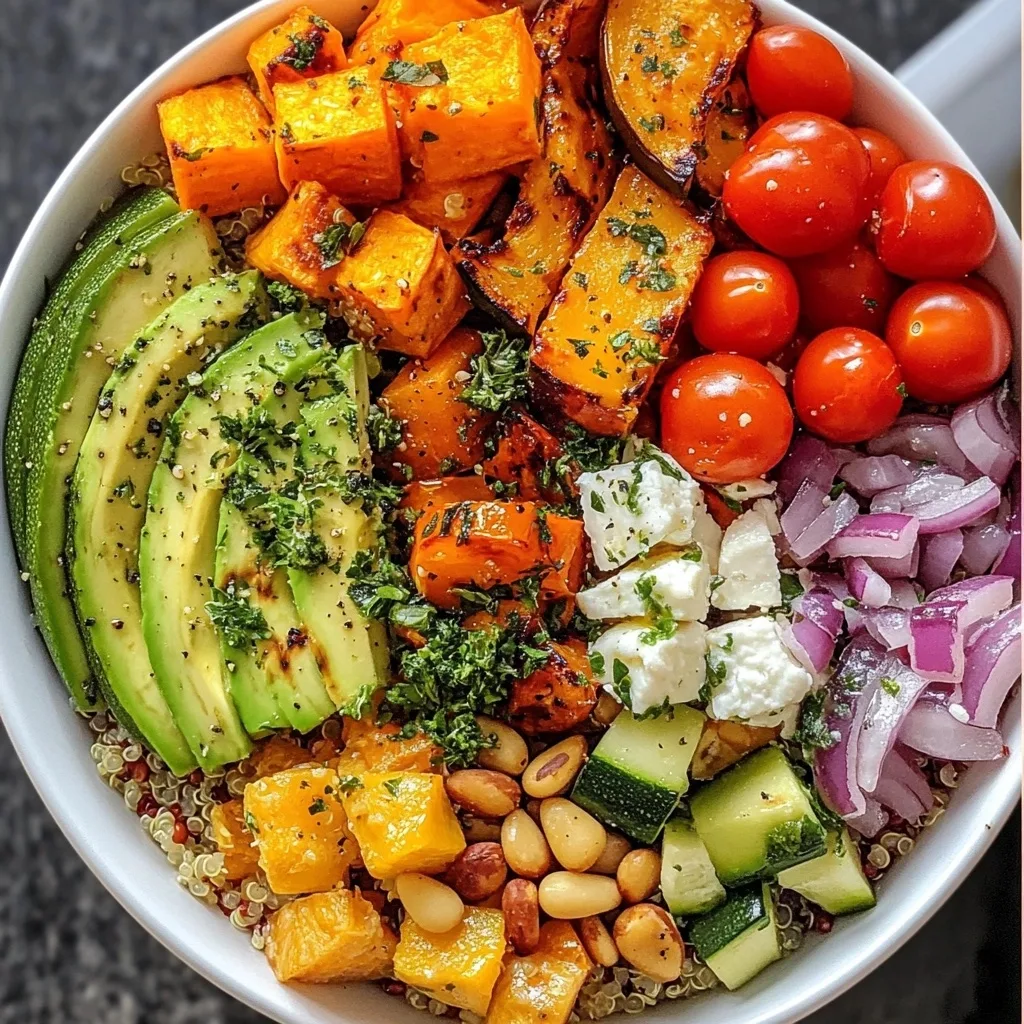This vibrant Roasted Vegetable Quinoa Bowl combines protein-rich quinoa with caramelized roasted vegetables and a bright lemon-herb dressing for a satisfying, nutritious meal that’s perfect for meal prep, weeknight dinners, or entertaining guests. Customizable, flavorful, and packed with wholesome ingredients, this bowl delivers both incredible taste and nourishment in every bite!
Introduction to Roasted Vegetable Quinoa Bowls
In today’s fast-paced world, finding meals that balance nutrition, flavor, and convenience can feel like searching for a unicorn. Enter the Roasted Vegetable Quinoa Bowl – a colorful culinary creation that delivers on all fronts without compromising on taste or health benefits. This versatile dish has become a staple in many kitchens, and for good reason.
Roasted Vegetable Quinoa Bowls represent the perfect marriage of nutty, protein-packed quinoa and caramelized roasted vegetables, all brought together with a zingy lemon-herb dressing that elevates every element on the plate. What makes this dish truly special is how it transforms simple, wholesome ingredients into a symphony of flavors and textures that satisfy both the palate and the body’s nutritional needs.
Whether you’re a seasoned home chef or just beginning your culinary journey, this Roasted Vegetable Quinoa Bowl recipe offers accessibility without sacrificing complexity of flavor. The roasting process brings out the natural sweetness in vegetables, creating depth and richness that pairs perfectly with the earthy notes of quinoa. Add a bright, tangy dressing and optional toppings for customization, and you’ve got a meal that can be adapted to any season, dietary preference, or occasion.
In this comprehensive guide, I’ll walk you through creating the perfect Roasted Vegetable Quinoa Bowl from start to finish, offering expert tips, nutritional insights, and serving suggestions along the way. Get ready to transform humble ingredients into a vibrant, nourishing meal that will become a regular feature in your cooking repertoire!
The Magic of Roasted Vegetables and Quinoa
Why Roasting Makes Vegetables Irresistible
There’s something truly magical about the transformation that happens when vegetables meet high heat in the oven. The roasting process caramelizes the natural sugars in vegetables, creating complex flavors and delightful textures that simply can’t be achieved through other cooking methods.
When you roast sweet potatoes, they develop a crispy exterior and a creamy, sweet interior that melts in your mouth. Bell peppers become sweeter and slightly charred, intensifying their natural flavors. Zucchini takes on a tender-yet-firm texture with concentrated taste, while red onions develop a wonderful sweetness that balances their natural sharpness. Cherry tomatoes burst with concentrated umami flavor, adding little pockets of juicy brightness throughout the dish.
Beyond flavor, roasting vegetables at high temperatures helps retain more nutrients compared to boiling or steaming. The dry heat locks in vitamins and minerals, making roasted vegetables not just delicious but nutritionally superior. The slight caramelization around the edges creates those irresistible browned bits that deliver maximum flavor in each bite.
Quinoa: The Perfect Protein-Packed Base
At the foundation of our bowl sits quinoa – an ancient grain that’s earned its “superfood” status through impressive nutritional credentials and remarkable versatility. Though often categorized as a grain, quinoa is technically a seed, and it delivers a complete protein profile containing all nine essential amino acids that our bodies can’t produce on their own. This makes quinoa particularly valuable for plant-based diets.
With its subtle nutty flavor and pleasantly fluffy texture, quinoa provides an ideal canvas for the bold flavors of roasted vegetables and zesty dressing. Its protein content (8 grams per cooked cup) and fiber (5 grams per cup) create a satisfying base that helps maintain stable blood sugar levels and keeps you fuller longer.
Cooking quinoa in vegetable broth rather than water infuses it with additional flavor from the first step, building layers of taste throughout the dish. The tiny germ that curls around each quinoa seed when cooked adds a delightful textural element that makes each bite interesting.
Together, roasted vegetables and quinoa create a harmonious balance of complex carbohydrates, plant proteins, and essential nutrients that form the perfect foundation for a nourishing meal. This dynamic duo proves that healthy eating doesn’t have to be bland or boring – quite the opposite!
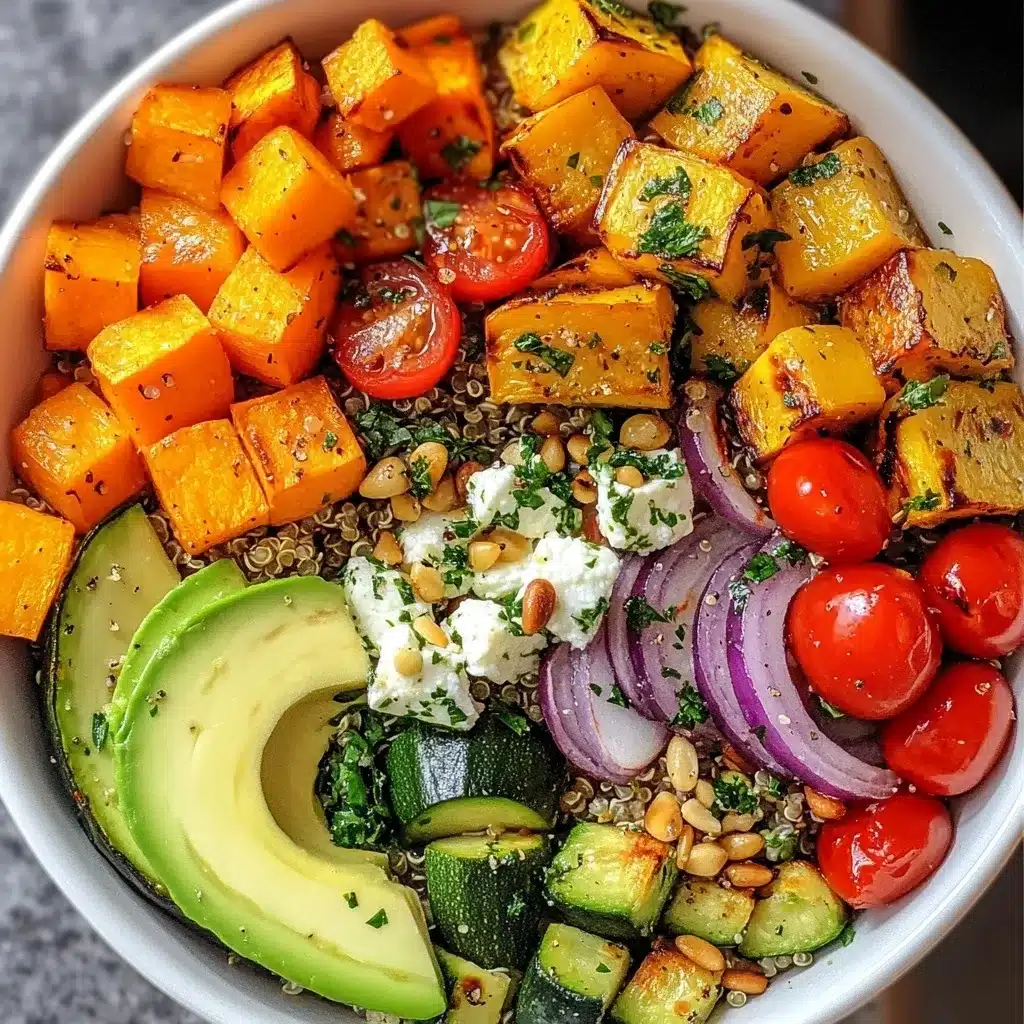
Essential Ingredients for the Perfect Bowl
Selecting and Preparing Your Vegetables
The beauty of a Roasted Vegetable Quinoa Bowl lies in its flexibility – while this recipe features a specific combination of vegetables, feel free to adapt based on seasonal availability or personal preference. Here’s what makes each component special:
Sweet Potatoes: These orange powerhouses provide natural sweetness, a satisfying starchy component, and loads of vitamin A and fiber. Cutting them into uniform 3/4-inch cubes ensures they’ll cook evenly alongside other vegetables.
Red Bell Peppers: With their vibrant color and sweet flavor, red peppers add vitamin C, antioxidants, and a pleasant crunch to contrast the softer vegetables. Choose peppers that feel heavy for their size with tight, shiny skin.
Zucchini: This summer squash contributes moisture, mild flavor, and a tender texture while staying low in calories. The half-moon cut showcases its beautiful green skin and white flesh.
Red Onion: Unlike its sharper relatives, red onion mellows wonderfully when roasted, offering natural sweetness and depth of flavor. Cutting into wedges allows each piece to develop caramelized edges while maintaining some texture.
Cherry Tomatoes: These little flavor bombs burst during roasting, releasing their natural juices and concentrating their sweetness. They add bright pops of color and acidity that balance the earthier elements.
For perfect roasting results, ensure all vegetables (except cherry tomatoes) are cut to similar sizes so they cook at the same rate. Thoroughly drying vegetables after washing helps them roast rather than steam, leading to better caramelization.
The Art of Perfect Quinoa
Despite its growing popularity, perfectly cooked quinoa still eludes many home cooks. Follow these tips for fluffy, flavorful quinoa every time:
Thorough Rinsing: Don’t skip this step! Quinoa has a natural bitter coating called saponin that must be rinsed away. Place quinoa in a fine-mesh strainer and rinse under cold water until the water runs clear.
Ideal Liquid Ratio: The perfect ratio is 1 part quinoa to 2 parts liquid. Using vegetable broth instead of water adds significant flavor to the final dish.
Cooking Method: Bring the liquid to a boil first, then add quinoa, reduce heat immediately, cover, and simmer. Resist the urge to peek or stir frequently – keeping the lid on traps steam that helps cook the quinoa evenly.
Resting Period: After cooking, remove from heat and let stand, covered, for 5 minutes. This final step allows excess moisture to be absorbed and the quinoa to achieve that perfect fluffy texture.
Fluffing Technique: Use a fork rather than a spoon to gently separate the grains without smashing them together.
White quinoa has the mildest flavor and fastest cooking time, but red and black varieties offer more distinct nutty flavors and slightly crunchier textures if you’re looking to experiment.
Creating a Vibrant Lemon-Herb Dressing
The dressing is far more than an afterthought – it’s the element that unifies all components and brings your Roasted Vegetable Quinoa Bowl to life. This bright lemon-herb creation offers several flavor dimensions:
Extra-Virgin Olive Oil: The foundation of the dressing provides healthy fats that help your body absorb the fat-soluble vitamins from the vegetables. Choose a good quality oil with a fresh, fruity flavor.
Fresh Lemon Juice: The acidity brightens the entire dish and cuts through the earthy flavors of quinoa and roasted vegetables. Always use freshly squeezed for the most vibrant flavor.
Dijon Mustard: Beyond adding tang, Dijon acts as an emulsifier that helps the oil and lemon juice combine into a smooth, cohesive dressing.
Honey or Maple Syrup: Just a touch of natural sweetener balances the acidity and brings harmony to the dressing. Maple syrup works perfectly for a vegan option.
Fresh Garlic: Minced fresh garlic provides a punchy aromatic element that permeates the entire bowl. For a milder flavor, try roasting the garlic clove alongside the vegetables.
Fresh Herbs: Parsley offers bright, clean flavor that complements without overwhelming. Feel free to experiment with dill, basil, or cilantro for different flavor profiles.
Whisking the dressing ingredients together creates a temporary emulsion. For longer-lasting results, combine ingredients in a jar with a tight-fitting lid and shake vigorously. The dressing can be made up to three days ahead and stored in the refrigerator – just bring to room temperature and shake again before using.
Step-by-Step Guide to Creating Your Bowl
Mastering the Vegetable Roasting Process
Perfect roasted vegetables are the star of this dish, and mastering a few techniques will elevate your results from good to extraordinary:
- Preheat Thoroughly: A properly preheated 425°F oven ensures immediate caramelization rather than steaming. Allow at least 20 minutes for your oven to reach full temperature.
- Proper Spacing: The cardinal rule of roasting is to avoid overcrowding. Give each vegetable piece space on the baking sheet – use two pans if necessary. Crowded vegetables steam each other, preventing those delicious browned edges from forming.
- Strategic Placement: Arrange denser vegetables like sweet potatoes toward the outer edges of the pan where heat is more intense. Place delicate items like cherry tomatoes closer to the center.
- Even Coating: Toss vegetables thoroughly with oil before arranging them – every piece should have a light, even coating that promotes browning without becoming greasy.
- Midway Tossing Technique: When turning vegetables halfway through roasting, use a spatula to get underneath them rather than stirring, which can break delicate pieces. For perfect browning, flip pieces so the unbrowned sides have direct contact with the hot pan.
- Visual Cues: Look for golden-brown edges, slight wrinkling of skins, and visible caramelization. The sweet spot is tender vegetables with caramelized exteriors, not mushy or burnt.
Remember that different vegetables have varying roasting times. If you’re substituting ingredients, harder vegetables like carrots and parsnips need longer cooking times, while softer ones like mushrooms require less time.
Quinoa Cooking for Maximum Fluffiness
Achieving perfectly fluffy quinoa creates the ideal foundation for your bowl:
- Measure Precisely: Use standard measuring cups for both quinoa and liquid to maintain the crucial 1:2 ratio.
- Watch for Boiling Signs: Look for a true rolling boil before adding quinoa – small bubbles around the edge aren’t enough.
- Temperature Control: Immediately reduce heat to the lowest setting once quinoa is added. If your stove runs hot, consider using a heat diffuser.
- Lid Discipline: The covered pot creates a mini pressure cooker environment. Lifting the lid releases steam and can result in unevenly cooked quinoa.
- Doneness Test: Quinoa is properly cooked when the tiny spiral germ has separated from the seed and most liquid is absorbed. A few tiny dots of moisture at the bottom of the pot is ideal.
- Resting Period: The 5-minute rest after cooking is non-negotiable. This allows remaining moisture to distribute evenly throughout the pot.
For meal prep purposes, quinoa can be cooked up to three days ahead and refrigerated. Reheat with a sprinkle of water in the microwave or at room temperature for cold bowls.
Assembly Strategies for Beautiful Bowls
Creating an instagram-worthy Roasted Vegetable Quinoa Bowl is about both aesthetics and flavor distribution:
- Temperature Harmony: For warm bowls, ensure all components are warm when assembling. For room temperature service (great for meal prep), allow everything to cool completely before combining.
- Base Layer Technique: Start with quinoa as your foundation, creating a slight well in the center to cradle the vegetables and catch the dressing.
- Vegetable Arrangement: Rather than mixing everything together, place vegetables in distinct sections around the bowl. This creates visual appeal and allows diners to appreciate each vegetable’s unique flavor.
- Dressing Application: Drizzle dressing in a circular pattern over the entire bowl rather than pouring it all in one spot. Use a spoon for more control than pouring directly from a jar.
- Finishing Touches: Add optional toppings last for maximum visual impact. Feta or goat cheese should be crumbled over the top rather than mixed in. Toasted nuts and seeds add texture and should remain visible. Fresh herbs provide a final pop of color.
For beautiful presentation when serving guests, consider using shallow, wide bowls in a solid color that contrasts with the vibrant vegetables. White, black, or earthy tones all work beautifully to showcase the colorful ingredients.
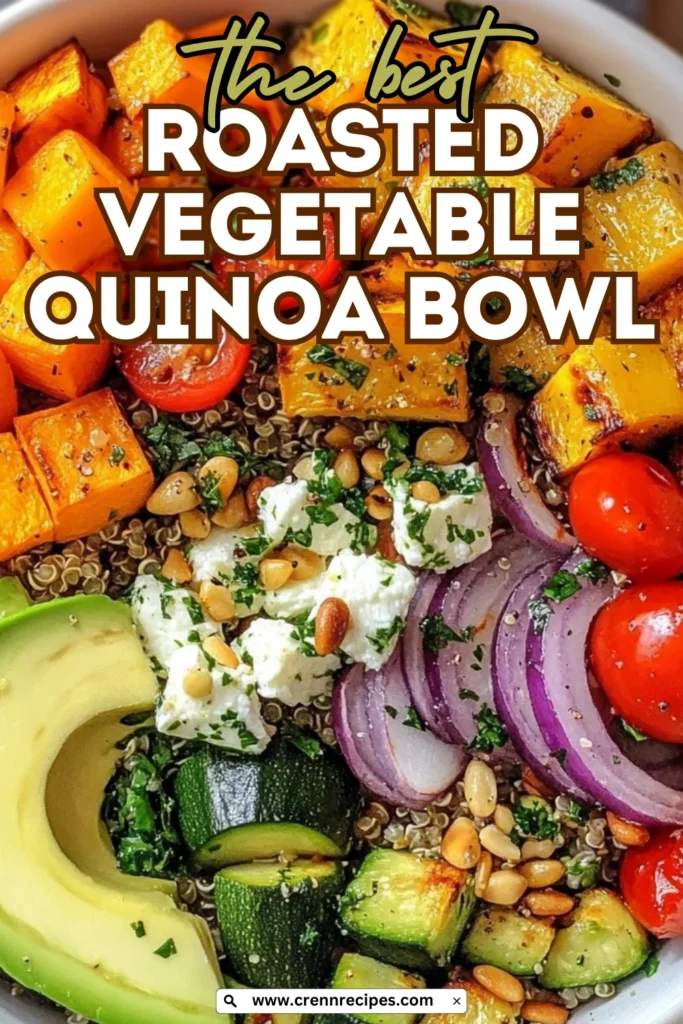
Nutrition and Health Benefits
The Powerhouse Nutritional Profile
Each component of the Roasted Vegetable Quinoa Bowl brings its own impressive nutritional credentials to create a genuinely balanced meal:
Quinoa delivers complete protein with all nine essential amino acids, making it exceptional among plant foods. One cup provides approximately 8 grams of protein and 5 grams of fiber. It’s also rich in magnesium, phosphorus, manganese, and B vitamins, supporting energy production and muscle function.
Sweet Potatoes are among the most nutritious vegetables available, loaded with beta-carotene (which converts to vitamin A), supporting eye health and immune function. They also provide vitamin C, potassium, and fiber while offering a low glycemic option that helps maintain steady blood sugar.
Bell Peppers contain more vitamin C than oranges, along with vitamin A, folate, and potassium. Their bright red color comes from the antioxidant lycopene, which may reduce inflammation and lower cancer risk.
Zucchini is exceptionally low in calories while providing vitamin A, vitamin C, potassium, and manganese. Its high water content helps with hydration while delivering nutrients.
Red Onions contain powerful antioxidants, particularly quercetin, which has anti-inflammatory properties. They also provide prebiotic fibers that support gut health.
Cherry Tomatoes pack a surprising amount of lycopene, potassium, and vitamins C and K into their small size. The concentration of nutrients increases during roasting.
Olive Oil in the dressing provides heart-healthy monounsaturated fats that help absorb fat-soluble vitamins from the vegetables while supporting cellular health.
Together, these ingredients create a balanced meal with approximately 350-400 calories per serving, 10-12 grams of protein, 7-9 grams of fiber, and abundant vitamins, minerals, and antioxidants.
Supporting Various Dietary Needs
One of the most appealing aspects of the Roasted Vegetable Quinoa Bowl is its adaptability to diverse dietary requirements:
Vegan/Vegetarian: The recipe is naturally vegetarian and becomes fully vegan by simply substituting maple syrup for honey in the dressing and omitting cheese toppings or using plant-based alternatives.
Gluten-Free: Quinoa is naturally gluten-free, making this an excellent option for those with celiac disease or gluten sensitivity. Just verify that your vegetable broth is certified gluten-free.
Dairy-Free: Skip the optional cheese toppings or substitute with nutritional yeast for a cheese-like flavor without dairy.
Low-FODMAP: Modify by omitting red onion and limiting cherry tomatoes, while focusing on low-FODMAP vegetables like bell peppers, carrots, and zucchini.
Mediterranean Diet: This bowl aligns perfectly with Mediterranean eating patterns, emphasizing plant foods, whole grains, and olive oil.
Anti-Inflammatory Focus: The combination of colorful vegetables, olive oil, and herbs provides a range of antioxidants and anti-inflammatory compounds that support overall health.
For those monitoring specific macronutrients, the bowl can be adapted to increase protein (add chickpeas or edamame), reduce carbohydrates (decrease quinoa portion, increase vegetables), or modify fat content (adjust dressing and toppings accordingly).
Seasonal Variations and Adaptations
Spring and Summer Roasted Vegetable Quinoa Bowl
When warmer months arrive, lighten up your bowl with these seasonal adaptations:
Spring Vegetables: Incorporate tender asparagus spears, snap peas, and radishes. Cut asparagus into 2-inch pieces and reduce roasting time to about 15 minutes to maintain their vibrant color and prevent overcooking.
Summer Bounty: Take advantage of peak-season produce like corn (cut from the cob and roasted until caramelized), yellow summer squash alongside zucchini, and colorful heirloom cherry tomatoes for visual appeal.
Herb Variations: Swap parsley for fresh basil, mint, or dill in the dressing. Try a basil-mint combination for a refreshing summer flavor.
Lighter Dressing: Create a more refreshing dressing by increasing lemon juice and adding a teaspoon of lemon zest. Reduce oil slightly for a brighter, lighter finish.
Cool Components: Consider serving on a bed of quinoa that’s been chilled after cooking, with warm roasted vegetables creating a pleasant temperature contrast.
Serving Style: For outdoor dining, these components work beautifully as a room-temperature salad, perfect for picnics and barbecues.
Fall and Winter Roasted Vegetable Quinoa Bowl
As temperatures drop, comfort can still be nutritious with these warming adjustments:
Hearty Fall Vegetables: Substitute butternut squash or delicata squash for sweet potatoes. Add cauliflower florets, Brussels sprouts halves, or parsnip cubes for seasonal variety.
Root Vegetable Medley: Create a hearty bowl with roasted carrots, turnips, and golden beets alongside the sweet potatoes. These dense vegetables benefit from slightly longer roasting times (30-35 minutes).
Warming Spices: Add cinnamon, cumin, or smoked paprika to the vegetable seasoning mix before roasting for deeper, more complex flavors.
Richer Dressing: Incorporate a tablespoon of tahini into the dressing for creaminess and warmth, complementing heartier winter vegetables.
Hot Serving Style: Ensure all components are piping hot when served, creating a comforting meal for colder evenings.
Additional Warmth: Consider adding roasted garlic cloves or caramelized onions for additional depth and sweetness that complements winter produce.
Throughout the year, focus on sourcing vegetables at their peak season for maximum flavor, nutrition, and value. Farmers’ markets offer excellent opportunities to discover unique varieties that can make your Roasted Vegetable Quinoa Bowl even more special.
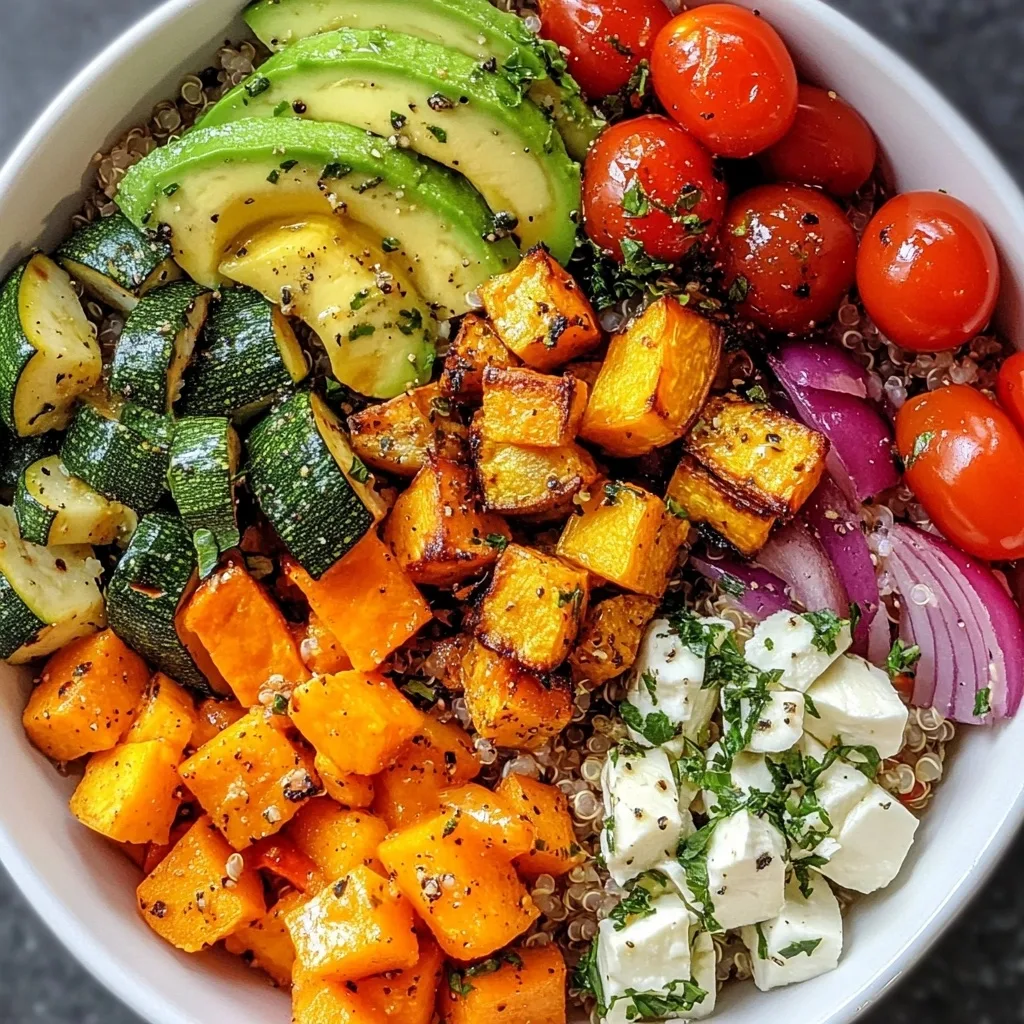
Storage, Meal Prep, and Serving Suggestions
Perfect for Make-Ahead Meals
The Roasted Vegetable Quinoa Bowl isn’t just delicious—it’s also an ideal candidate for meal preparation:
Component Storage: Each element can be prepared separately and stored for optimal freshness:
- Cooked quinoa stays fresh in an airtight container in the refrigerator for up to 5 days
- Roasted vegetables maintain their flavor and texture for 3-4 days refrigerated
- Lemon-herb dressing will keep for up to a week in a glass jar in the refrigerator
Assembly Strategies: For meal prep, you have two excellent options:
- Store components separately and assemble fresh each day for optimal texture
- Pre-assemble complete bowls without dressing, storing in microwave-safe containers for grab-and-go convenience
Reheating Guidelines: Quinoa can become dry when refrigerated. When reheating, add a sprinkle of water before microwaving on 70% power, covered, for 1-2 minutes. Roasted vegetables can be reheated alongside or enjoyed at room temperature for contrasting textures.
Freezing Options: Cooked quinoa freezes beautifully for up to 2 months. Portion into freezer bags, press flat to remove air, and thaw overnight in the refrigerator. Most roasted vegetables (except zucchini and tomatoes) can also be frozen, though texture will soften slightly upon thawing.
For busy weeks, consider a Sunday prep session: cook a double batch of quinoa, roast several sheet pans of vegetables, prepare dressing, and portion optional toppings into small containers. With this approach, you’ll have nutritious meals ready in minutes throughout the week.
Creative Serving Ideas for Various Occasions
The versatility of Roasted Vegetable Quinoa Bowls makes them suitable for everything from quick weeknight dinners to impressive entertaining:
Family Dinner: Serve family-style on a large platter with components arranged in sections, allowing everyone to customize their own bowl. Include additional toppings in small bowls for a “build-your-own” experience that pleases even picky eaters.
Lunch Packing: For work or school lunches, invest in containers with dividers to keep components separate until eating time. Pack dressing in a leak-proof container and dress just before eating.
Elegant Entertaining: Elevate the presentation by serving in wide, shallow bowls with components artfully arranged. Add premium touches like marcona almonds instead of regular, microgreens as garnish, or a drizzle of aged balsamic vinegar.
Alongside Protein: Though satisfying on its own, the bowl pairs beautifully with:
- Grilled salmon or chicken for additional protein
- Baked tofu for a plant-based protein boost
- A poached or soft-boiled egg for a luxurious brunch variation
Temperature Variations: While typically served warm, these bowls are equally delicious at room temperature for picnics or outdoor gatherings. For chilly days, serve components hot from the oven for maximum comfort.
Remember that the visual appeal of these colorful bowls is part of their charm. Taking an extra moment for thoughtful arrangement creates a more satisfying eating experience, engaging all the senses.
Frequently Asked Questions About Roasted Vegetable Quinoa Bowls
Common Questions and Expert Answers
Q: Can I make this Roasted Vegetable Quinoa Bowl ahead of time?
A: Absolutely! This dish was designed with meal prep in mind. Cook the quinoa and roast the vegetables up to 3-4 days ahead, storing them separately in airtight containers in the refrigerator. The dressing can be prepared up to a week in advance. Assemble just before serving or pre-assemble without dressing for grab-and-go meals.
Q: How do I prevent quinoa from becoming mushy?
A: Perfect quinoa relies on three key techniques: use the correct 1:2 ratio of quinoa to liquid, avoid overcooking by setting a timer for exactly 15 minutes, and most importantly, let it rest covered for 5 minutes after cooking before fluffing with a fork. For best results, avoid stirring during cooking and resist lifting the lid to peek until the cooking time is complete.
Q: What can I substitute if I don’t have some of the specified vegetables?
A: This recipe is incredibly flexible! Good substitutions include:
- Carrots, parsnips, or butternut squash instead of sweet potatoes
- Any color bell pepper works well
- Yellow squash can replace zucchini
- Regular tomatoes cut into chunks can substitute for cherry tomatoes
- Yellow onion or shallots can replace red onion The key is cutting vegetables to similar sizes so they roast evenly.
Q: Is there a good substitute for quinoa?
A: While quinoa provides excellent nutrition and texture, you can substitute other grains based on preference or pantry availability:
- Farro offers a chewy texture and nutty flavor (not gluten-free)
- Brown rice provides a neutral base that’s widely available
- Millet is a gluten-free option with a mild flavor similar to quinoa
- Buckwheat offers a robust, earthy taste (despite the name, it’s gluten-free) Adjust cooking times and liquid ratios according to your chosen grain.
Q: How can I add more protein to this bowl?
A: While quinoa provides decent plant-based protein, you can boost the protein content by:
- Adding a cup of chickpeas or black beans
- Including edamame or green lentils
- Topping with grilled chicken, salmon, or shrimp
- Adding tofu, tempeh, or seitan for plant-based options
- Including a soft-boiled egg for vegetarians These additions make the bowl even more satisfying as a complete meal.
Q: Can this recipe be made oil-free?
A: Yes, though with some texture differences. For the vegetables, replace oil with a few tablespoons of vegetable broth or aquafaba (chickpea cooking liquid) before roasting. They won’t caramelize quite as well but will still develop flavor. For the dressing, create an oil-free version using additional Dijon mustard, a tablespoon of tahini, and extra lemon juice whisked with herbs and seasonings.
Enjoy Your Roasted Vegetable Quinoa Bowl
The Roasted Vegetable Quinoa Bowl represents the perfect balance of nutrition, flavor, and versatility. By combining protein-rich quinoa with a rainbow of roasted vegetables and bringing it all together with a bright lemon-herb dressing, you’ve created a meal that nourishes both body and soul.
What makes this dish truly special is its adaptability. Whether you’re following the recipe exactly or making substitutions based on seasonal availability and personal preference, the fundamental techniques of properly cooking quinoa and mastering vegetable roasting will serve you well. The bowl concept itself invites creativity—feel free to make it your own with different vegetables, grains, dressings, and toppings.
Beyond its delicious flavor profile, this Roasted Vegetable Quinoa Bowl delivers impressive nutritional benefits. From complete proteins to fiber, vitamins, minerals, and antioxidants, each component contributes to a truly balanced meal that supports your health goals without sacrificing satisfaction.
Whether you’re preparing a quick weeknight dinner, meal prepping for busy days ahead, or serving a casual gathering of friends, these colorful bowls bring joy to the table. The combination of textures, flavors, and visual appeal creates an eating experience that feels special, even on ordinary days.
I hope this Roasted Vegetable Quinoa Bowl becomes a beloved recipe in your regular rotation, offering nourishment, satisfaction, and culinary creativity for years to come!
More Related Recipes You Might Enjoy
If you loved this Roasted Vegetable Quinoa Bowl, you’ll appreciate these other nutritious, flavorful recipes that share similar ingredients or preparation methods:
- Healthy Mediterranean Salmon Bowl for Fall – Another nourishing bowl concept that pairs perfectly with similar vegetables and adds heart-healthy protein.
- Quick Acorn Squash with Quinoa – Features the same nutritious quinoa base with seasonal squash for a comforting variation.
- Honey Roasted Butternut Squash – Master the vegetable roasting technique with this sweet and savory side dish that could easily be incorporated into your quinoa bowl rotation.
These recipes all share the spirit of nutritious, flavorful eating with whole food ingredients and straightforward preparation methods. They make excellent additions to a health-conscious meal plan that doesn’t sacrifice flavor or satisfaction!
Print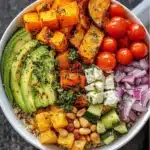
Roasted Vegetable Quinoa Bowl: 7 Incredible Secrets Revealed
- Total Time: 45 minutes
- Yield: 4 servings 1x
- Diet: Vegetarian
Description
This vibrant Roasted Vegetable Quinoa Bowl is the perfect balance of nourishment and flavor! Protein-rich quinoa, caramelized roasted veggies, and a bright lemon-herb dressing come together for a colorful meal that’s as Instagram-worthy as it is delicious. Customize with your favorite toppings for an easy, versatile dish that works for meal prep, weeknight dinners, or entertaining guests!
Ingredients
- 1 cup quinoa, rinsed well
- 2 cups low-sodium vegetable broth (or water)
- Pinch of sea salt
- 1 medium sweet potato, peeled and cubed (about 1½ cups)
- 1 red bell pepper, deseeded and chopped
- 1 small zucchini, sliced into half-moons
- 1 red onion, cut into wedges
- 1 cup cherry tomatoes
- 2 tablespoons olive oil
- 1 teaspoon dried Italian seasoning
- Salt & freshly cracked black pepper, to taste
- ¼ cup extra-virgin olive oil
- 2 tablespoons fresh lemon juice (about 1 lemon)
- 1 teaspoon Dijon mustard
- 1 teaspoon honey (or maple syrup for vegan)
- 1 garlic clove, minced
- 2 tablespoons fresh parsley, finely chopped
- Salt & pepper, to taste
- Optional toppings: crumbled feta or goat cheese, toasted pine nuts or chopped walnuts, avocado slices, fresh basil leaves
Instructions
- Preheat your oven to 425°F (220°C). Line a large baking sheet with parchment paper or brush with a thin layer of oil.
- In a big bowl, toss sweet potato, bell pepper, zucchini, onion, and cherry tomatoes with olive oil, Italian seasoning, salt, and pepper. Spread in a single layer on your sheet pan. Roast for 20–25 minutes, tossing once halfway, until edges are golden and vegetables are tender.
- While the veggies roast, bring the vegetable broth and pinch of salt to a boil in a medium saucepan. Stir in the quinoa, reduce heat to low, cover, and simmer for 15 minutes, until all liquid is absorbed. Remove from heat, fluff with a fork, and set aside.
- In a small bowl or jar with a lid, whisk together olive oil, lemon juice, Dijon mustard, honey, minced garlic, parsley, salt, and pepper. Taste and adjust—add more honey if you like it sweeter, or extra lemon for more zing.
- To assemble, spoon a generous bed of fluffy quinoa into each bowl. Arrange the roasted veggies on top. Drizzle with the lemon-herb dressing, then add any optional toppings you desire—crumbled cheese, nuts for crunch, creamy avocado, or fresh herbs.
- Serve immediately and enjoy this colorful, nutritious meal!
Notes
- For meal prep: Store components separately for up to 4 days. Assemble just before eating or pack complete bowls without dressing.
- Customize with seasonal vegetables: Try butternut squash in fall, asparagus in spring.
- To make vegan: Use maple syrup instead of honey and skip the cheese or use plant-based alternatives.
- For extra protein: Add chickpeas, black beans, grilled chicken, or a soft-boiled egg.
- The secret to perfect roasted vegetables is giving them plenty of space on the baking sheet—use two pans if needed to avoid overcrowding.
- Prep Time: 15 minutes
- Cook Time: 30 minutes
- Category: Main Dish
- Method: Roasting
- Cuisine: Mediterranean
Nutrition
- Serving Size: 1 bowl (approximately 2 cups)
- Calories: 385
- Sugar: 6g
- Sodium: 320mg
- Fat: 22g
- Saturated Fat: 3g
- Unsaturated Fat: 18g
- Trans Fat: 0g
- Carbohydrates: 42g
- Fiber: 7g
- Protein: 9g
- Cholesterol: 0mg

